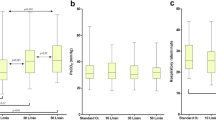Abstract
Objective: In patients with chronic obstructive pulmonary disease (COPD), intratracheal oxygen insufflation (ITO) is an established therapeutic approach. We developed a new endoscopic technique of intratracheal catheter placement. The aim of this pilot study was to demonstrate its short-term feasibility in acutely extubated patients with moderate to severe COPD who require oxygen therapy. Design: A guide wire was inserted through a nasally passed bronchoscope and was positioned such that its tip was placed intratracheally. Using a “Seldinger technique“, the tracheal catheter was then inserted over the wire to a point 2–3 cm proximal to the carina and positioned under direct vision from the bronchoscope inserted through the contralateral nose. After catheter insertion, the guide wire was removed. The patients scored catheter-associated local discomfort using a visual analogue scale. In a randomly assigned, crossover design, the effectiveness of the endoscopically (e) inserted ITO catheter was assessed by measuring the capillary blood gases, respiratory rate (RR), tidal volume (Vt) and minute ventilation (MV) after 1 h breathing room air without eITO and 1 h after eITO (flow: 3 l/min). Measurements and results: The eITO catheter was placed in all patients without complications and with only minimal discomfort in two patients (spontaneously reversible cough). Compared to breathing room air, capillary O2 pressure increased (from 54.7 ± 9.4 to 82.8 ± 21.8 mmHg) whereas Vt (from 458.7 ± 86.8 to 358.3 ± 75.1 ml) and MV (from 7.7 ± 1.5 to 5.5 ± 1.1 l/min) decreased significantly (each p < 0.0001) with eITO in all patients. The capillary CO2 pressure and RR did not change. Conclusions: Acutely extubated patients in whom oxygen therapy is indicated may profit from eITO. This new technique works immediately and is thus an effective short-term intervention of potential value in the intensive care unit.
Similar content being viewed by others
Author information
Authors and Affiliations
Additional information
Received: 6 September 1996 Accepted: 2 January 1997
Rights and permissions
About this article
Cite this article
Schönhofer, B., Geibel, M., Stickeler, P. et al. Endoscopic placement of a tracheal oxygen catheter: a new technique. Intensive Care Med 23, 445–449 (1997). https://doi.org/10.1007/s001340050356
Issue Date:
DOI: https://doi.org/10.1007/s001340050356




